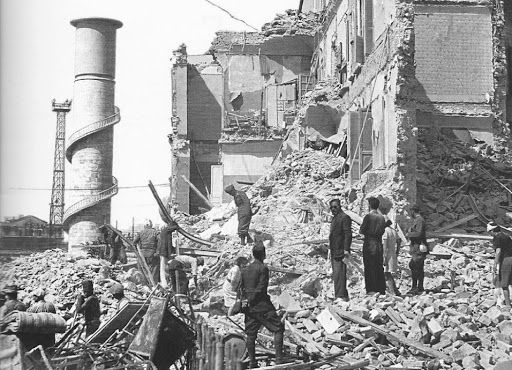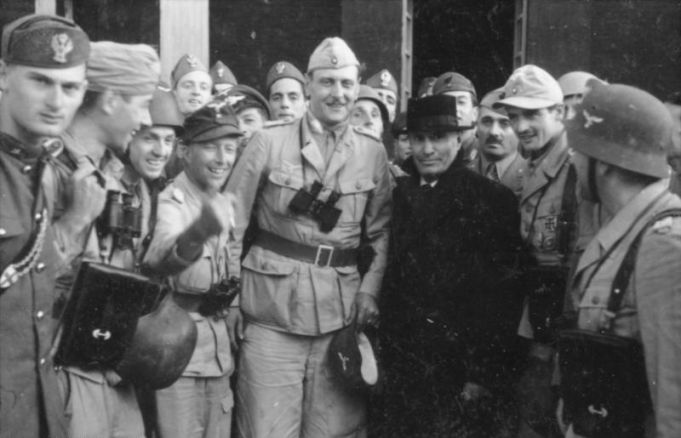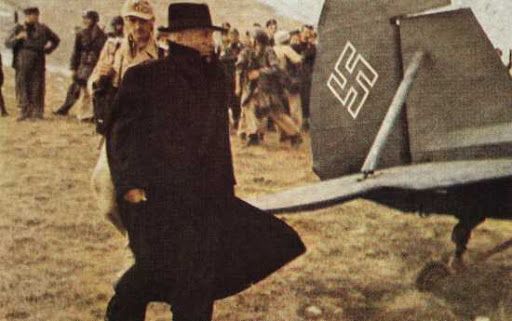Operation Eiche, when Mussolini was rescued by the Nazis.
On the 25th of July, 1943, Italian Fascist dictator Benito Mussolini was arrested at Villa Savoia in Rome. Mussolini’s arrest brought an end to 21 years of Fascist rule in the country. Although he had once brought hope and prosperity to the Kingdom of Italy, years of war had demoralized the population and Italy was on the brink of defeat.In December of 1942, Italy’s African front had collapsed and Allied forces moved into North Africa, leaving Italy vulnerable to invasion. Italian forces had also suffered massive casualties on the Eastern front, as the Soviet Union grew increasingly confident as they moved west.
Then, on July 10th, Allied forces landed in Sicily. Though the Italians were expecting an invasion on the island, their forces were quickly overwhelmed, with many simply surrendering without a fight. Nine days later, on the 19th of July, Allied bombers appeared over Rome.The bombers flattened the working-class neighborhood of San Lorenzo (photo below), damaged two of Rome's airports, and caused extensive damage to the ancient Basilica of Saint Lawrence. For the Italians, this was the final straw.

A vote of no confidence was successfully passed at a meeting of the Grand Council of Fascism on the 24-25 of July 1943. Mussolini was subsequently placed under arrest, and a new government was installed with Marshall Pietro Badoglio taking his place.
In Germany, Hitler was shocked. Watching his fellow dictator be betrayed by his own party made him fearful that he could suffer the same fate. He was also fearful that Italy may now be hostile territory for the troops that he had sent south to assist the Italians. His only option was to free Mussolini and reinstall him as leader of the country.
Otto Skorzeny

The two that he assigned were Hauptsturmfurher Otto Skorzeny (in the photo) to track Mussolini’s location, while simultaneously ordering paratroop General Kurt Student to execute the liberation.
Born in Vienna, Austria-Hungary in 1908, Otto Skorzeny originally had aspirations of becoming a pilot in the Luftwaffeafter the invasion of Poland in 1939. However, at the age of 31, he was deemed to be too old, and standing at 1.92 meters (6ft 4in), too tall as well. He, therefore, joined Hitler's bodyguard regiment, the Leibstandarte SS Adolf Hitler. Skorzeny was not only recognizable by his height, but also by the massive "dueling scar" that ran down his left cheek, a common mark of prestige among the Nazis.
Skorzeny would take part in the invasion of the Soviet Union and saw extensive action on the Eastern Front. He played an important role in the German's attempt to take Moscow, which they ultimately failed to do. Then, in December of 1942, Skorzeny was hit in the back of the head by a piece of shrapnel and was evacuated to the rear.He was awarded the Iron Cross and given a staff role in Berlin while he recuperated from his injuries. It was during his recovery that he began developing ideas for unconventional commando warfare. Skorzeny proposed developing specialized units that would take part in these commando missions. Their tasks would include partisan-like fighting deep behind enemy lines, fighting in enemy uniform, and sabotage attacks to name a few.
In April of 1943, Skorzeny got his chance as his name was put forward by the new head of the Reich Main Security Office (RSHA) Ernst Kaltenbrunner. He subsequently met with Walter Schellenberg, head of the RSHA’s SS foreign intelligence service department, who put him in command of the schools designed to train units in sabotage, espionage, and paramilitary techniques.Skorzeny was made commander of the recently created special forces unit the Waffen SS Jagdverband 502. The unit's first mission involved parachuting into Iran to make contact with dissident mountain tribes and convince them to sabotage Allied supplies being sent to the Soviet Union along the Trans-Iranian Railway. However, the operation was deemed a failure as the commitment of the tribesmen was suspect.
Liberation of Mussolini

Then, after intercepting a coded Italian radio message, Skorzeny used reconnaissance from agents and informants of SS Obersturmbannfuhrer Herbert Kappler and determined that Mussolini was being held at Hotel Campo Imperatore in Gran Sasso, high in the Apennine Mountains, in Abruzzo. The hotel was accessible only by a cable car and was defended by 200 Carabinieri troops.
Skorzeny worked closely with Germany’s paratroops, the Fallschirmjager, in planning the rescue operation. The first option that was considered was a parachute attack, but this was ruled out when it was determined that the air would be too thin for parachutes at such a high altitude.After looking at reconnaissance photos of the location, Skorzeny noticed what looked to be a large flat area next to the hotel that would be ideal for a glider landing. It was also imperative that the base of the cable car at the foot of the mountain be captured, to prevent any interference from the Italians during the rescue operation. This task would be carried out by two paratroop units led by Major Harald Mors. Once the cable car was taken, Mors and some of his men would travel up the mountain to assist the assault team.
The glider operation involved ten DFS 230 gliders, which would be towed by Henschel Hs 126 planes. Each glider would carry a pilot along with nine men. The operation took place on the 12 September 1943.At around 13:00 that day, the glider operation commenced as they departed from the Practica di Mare Air Base near Rome. Oberleutnant Georg Freiherr von Berlepsch, the leader of the airborne operation, entered the first glider, while Skorzeny and his men entered the fourth and fifth. In an attempt to gain height while flying over the Alban Hills, the leading three glider-towing planes flew an additional loop. However, the rest of the planes didn't think this was necessary and as a result, Skorzeny's glider would arrive first to the target.
Meanwhile, at 14:00, Major Harald Mors captured the cable car station leading to the hotel. Mors also made sure to cut all telephone lines at the station, ensuring there would be no interference from the Italians.Just after, at 14:05, the ten gliders landed on the mountain near the hotel, with one crashing and injuring all ten men on board. Skorzeny and his commandos along with the paratroops overwhelmed the 200 Carabinieri that was guarding Mussolini, not a single shot was fired. Italian African Police force General Fernando Soleti had flown with Skorzeny and ordered all of Mussolini's guards to stand down. After just ten minutes, Mussolini left the hotel accompanied by the German soldiers. General Mors arrived at 14:45 via the cable car and introduced himself to Mussolini.
Mussolini's way off of the mountain would be in a Fieseler Fi 156 STOL plane. Even though the plane was only rated to handle two people, Skorzeny insisted on accompanying Mussolini. Skorzeny knew that if anything happened to the Italian dictator, he would have to pay with his life. The addition of a third person in the small plane meant that it was dangerously overloaded, but if Skorzeny was going to die, he preferred it was alongside the man he had just daringly rescued.The plane made an extremely dangerous but successful takeoff, in which the plane at one point appeared to plummet into the valley before the pilot managed to get the nose up and fly away.

Although the operation was the work of General Kurt Student and his paratroops, Skorzeny and the 16 SS commandos who accompanied him received the majority of the credit for Mussolini's rescue. This was in large part thanks to Reichsfuhrer-SS Heinrich Himmler and the propaganda minister Joseph Goebbels who, after a pro-SS propaganda coup, ensured that Skorzeny and his SS Special Forces be considered the heroes of this immensely important operation.
Skorzeny was awarded the Knights Cross of the Iron Cross, solidified his status as the “most dangerous man in Europe” and even drew praise from Winston Churchill. Mussolini was paraded in front of cameras with the imposing presence of Skorzeny by his side, and the Germans gave the impression that the tide of war had turned back in their favor.
The Aftermath

Mussolini knew this as well, the rescue was a hollow victory for him. He was now no more than one of Hitler's puppets, who installed him as the leader of the newly-created Italian Social Republic. In an interview with Madeleine Mollier, who had interviewed Mussolini back in 1938 when Mussolini was at the height of his power, now he knew that his end was drawing near "Seven years ago, I was an interesting person. Now, I am little more than a corpse… Yes, madam, I am finished. My star has fallen. I have no fight left in me. I work and I try, yet know that all is but a farce ... I await the end of the tragedy and, strangely detached from everything, I do not feel any more an actor. I feel I am the last of spectators.”
Then, on the 27 of April 1945, as Allied forces battled their way through Northern Italy, Mussolini along with his mistress and entourage were captured by Italian partisans in the village of Dongo near Lake Como while trying to flee to neutral Switzerland. The next day, he was executed by a firing squad. The body of the once-mighty Il Duce, along with the bodies of his mistress and several of his supporters, all unceremoniously strung up from the roof of an Esso petrol station in Milan.General Info
View on Map
How the Nazis helped Mussolini to escape from Campo Imperatore
Campo Imperatore, 67100 L'Aquila AQ, Italy


















